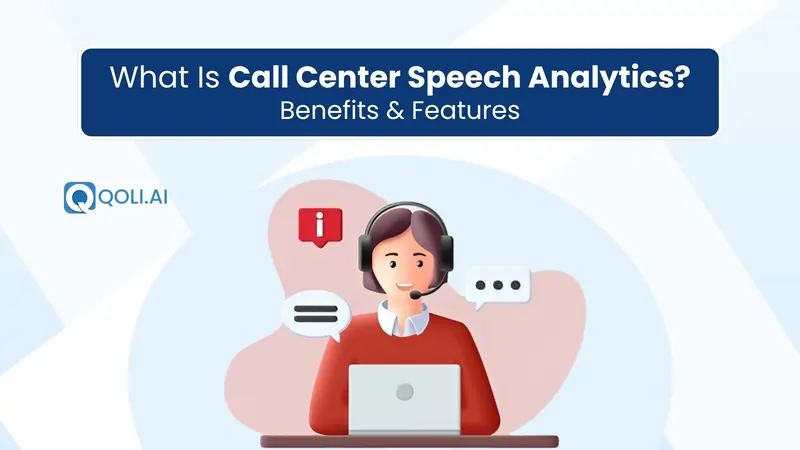What Is Call Center Speech Analytics? Benefits & Features
Unlock the power of call center speech analytics. Explore its key features, benefits, and real ways to boost customer experience, agent performance, and growth.
Author: Sujith Grandhi
Unlock the power of call center speech analytics. Explore its key features, benefits, and real ways to boost customer experience, agent performance, and growth.
Author: Sujith Grandhi

Every call in a contact center carries hidden insights. Beyond the words spoken, there’s tone, emotion, and intent, all of which can shape customer satisfaction and business growth. This is where call center speech analytics comes in.
In simple terms, speech analytics uses AI to listen, transcribe, and analyse customer conversations. It helps you understand not just what customers say, but how they feel. From spotting frustration early to finding sales opportunities, speech analytics turns routine calls into powerful data for decision-making.
In this guide, you’ll learn exactly what call center speech analytics is, its key features, real benefits, practical use cases, and even the challenges to watch out for. By the end, you’ll know how to use it to improve both customer experience and your business performance.
Call center speech analytics is the process of using technologies like Automatic Speech Recognition (ASR) and Natural Language Processing (NLP) to turn recorded conversations into structured data. Instead of simply storing call recordings, it transcribes speech into text, detects keywords, measures sentiment, and highlights patterns you can act on.
This means you don’t have to listen to thousands of calls manually. The system automatically pinpoints customer pain points, tracks compliance risks, and reveals trends across conversations.
At its core, speech analytics helps you understand three things:
In short, it transforms raw conversations into actionable insights that drive customer satisfaction, agent coaching, and smarter business decisions.
Customers won’t always say directly when they’re unhappy, but their tone, choice of words, and call patterns tell the story. Without speech analytics, most of these insights get lost.
With it, you can:
And with Qoli, you go beyond just speech analytics. Qoli offers a full suite of call management solutions, including call recording, contact tracking, real-time alerts, performance dashboards, and workflow insights. This means you’re not just analyzing calls, you’re managing, monitoring, and improving your entire call center operation, all from one platform.
In short, using Qoli with speech analytics gives you complete visibility and control, helping you act faster, improve processes, and keep both customers and your team happy.
Call center speech analytics isn’t just about recording calls, it gives you tools to understand conversations and take action. Here are the key features you should know:
These features work together to give you clear insights, faster decisions, and better customer experiences, all without manually listening to every conversation.
Speech analytics gives you clear insights from every customer call so you can make smarter decisions and improve your team’s performance. Here’s how it helps:
With these benefits, you’re not just collecting call data, you’re turning it into actionable insights that make your team and business stronger.
Speech analytics gives you data, but the real impact comes when you turn insights into action. Here’s how businesses can use it effectively:
1. Identify Recurring Problems
Analyze conversations to find patterns in customer complaints or common questions. Fixing these issues at the source reduces repeat calls and improves satisfaction.
2. Coach Agents With Precision
Instead of random call sampling, use analytics to see exactly where agents excel or need improvement, then provide targeted training.
3. Enhance the Customer Experience
Understand customer sentiment in real time to resolve issues faster and make interactions more personalized.
4. Optimize Processes and Workflows
Spot inefficient handoffs, repeated steps, or bottlenecks in call handling and streamline them for smoother operations.
5. Discover Upsell and Cross-sell Opportunities
Detect when customers express interest or unmet needs during calls and guide agents to offer relevant products or services.
6. Measure and Track Improvements
Set KPIs (Key Performance Indicators) and use analytics dashboards to monitor the impact of your changes. This ensures every action you take is measurable and leads to real business growth.
Call center speech analytics offers great insights, but it comes with its own set of challenges. Here’s what businesses should keep in mind:
👉 You Might Like This: What Is Contact Center Management? Skills & Strategies
Call center speech analytics is all about turning conversations into insights that matter. It helps you spot recurring issues, understand customer frustrations, and coach your agents to perform better.
By analyzing calls, you can streamline workflows, improve service quality, and make smarter business decisions. It also helps you identify opportunities for upselling, reduce compliance risks, and prevent problems before they escalate.
In short, speech analytics isn’t just about listening to calls, it’s about understanding your customers, improving your team, and driving real results for your business.